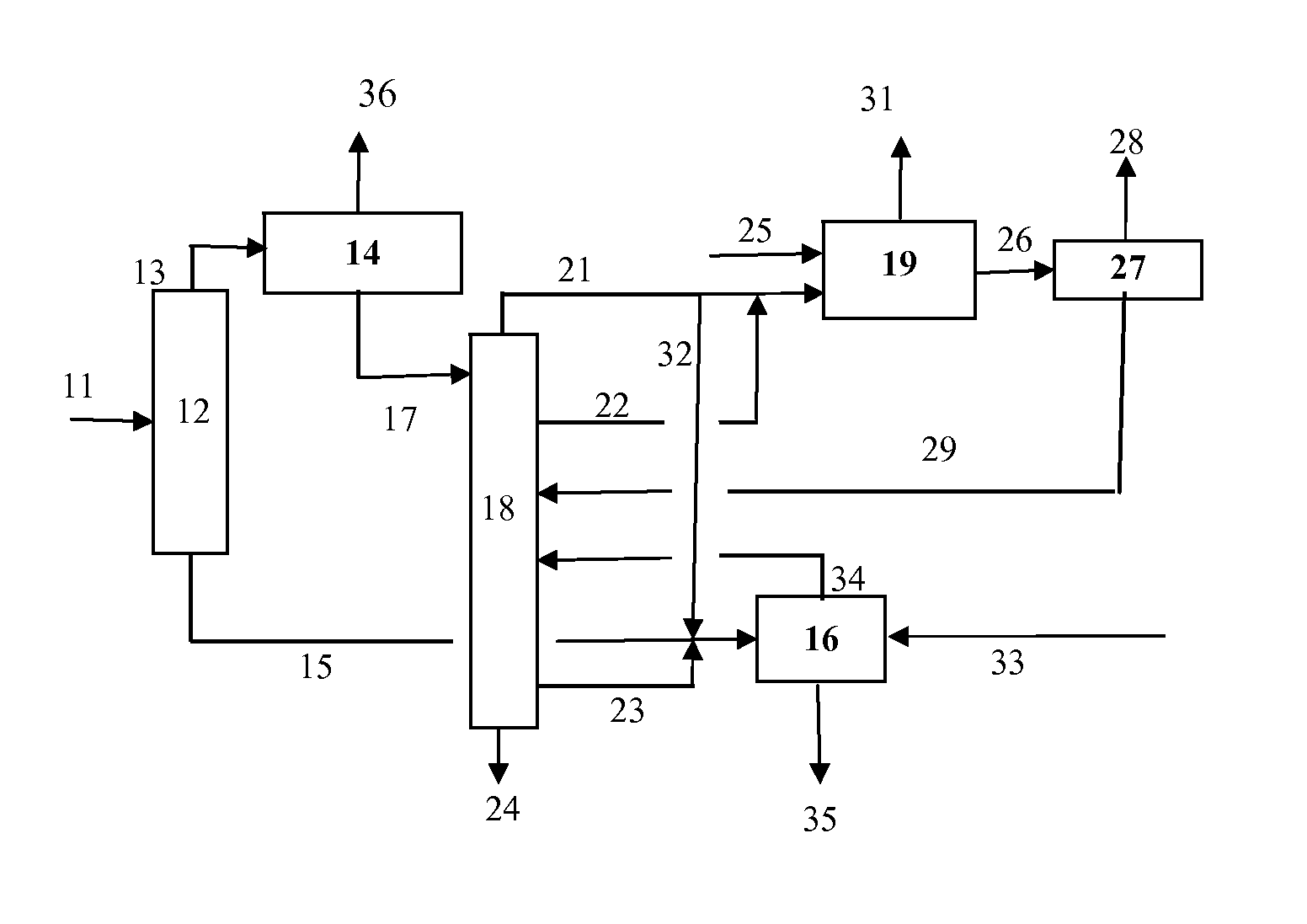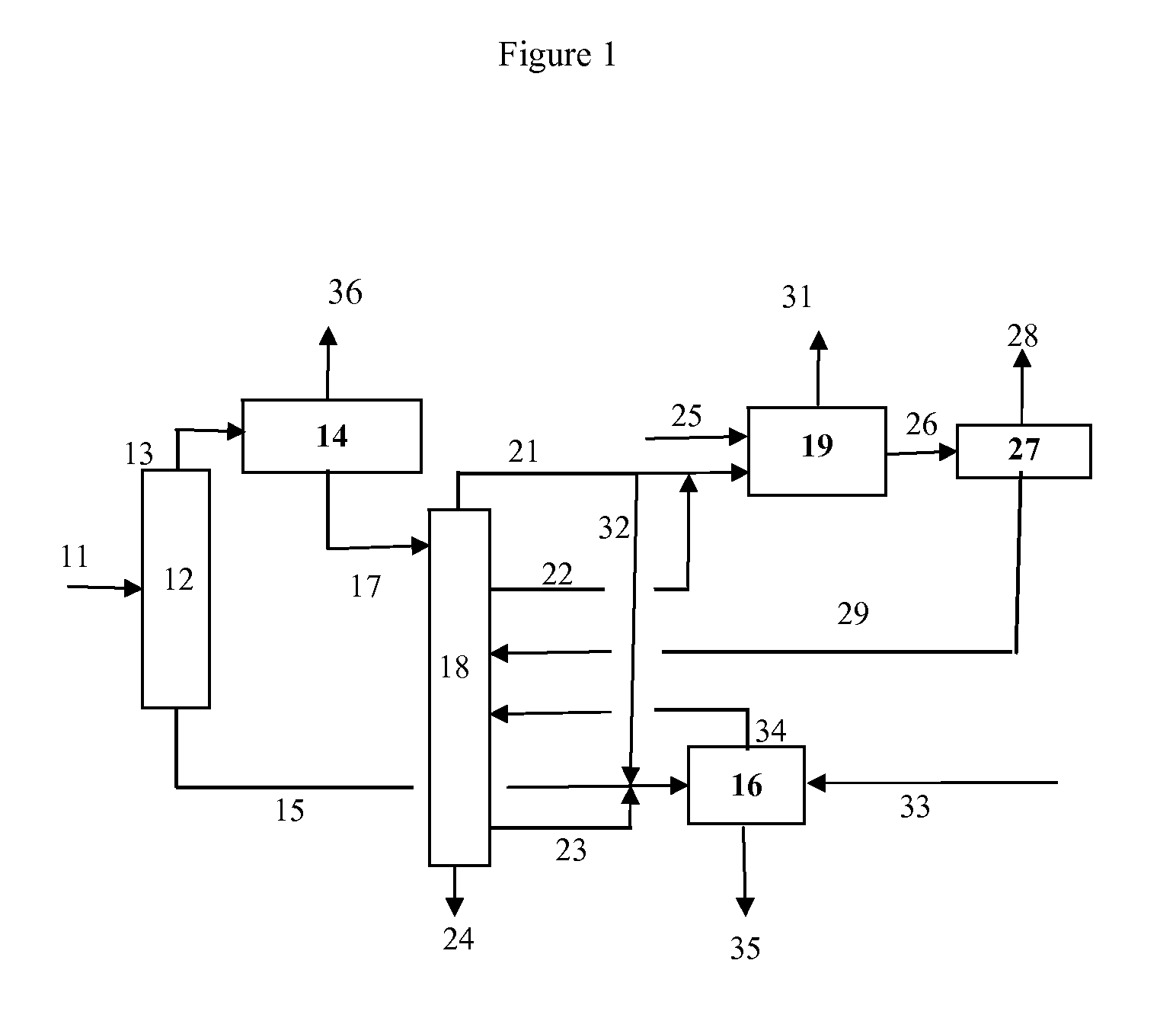Process for the Production of Xylenes
a technology of xylene and xylene, which is applied in the direction of thermal non-catalytic cracking, hydrocarbon oil treatment products, and alkylation treatment, etc., can solve the problems of reducing overall investment, high hydrogen consumption, and low value products such as lpg, and achieves the effect of increasing benzen
- Summary
- Abstract
- Description
- Claims
- Application Information
AI Technical Summary
Benefits of technology
Problems solved by technology
Method used
Image
Examples
example 2
[0117]Table 2 provides the estimated aromatics material balance for a hydrocarbon upgrading process as described in Example 1 but with extraction of the C7− aliphatic component before the D / T / C step.
[0118]Comparing Tables 1 and 2, it will be seen, using the same amount of feed from the steam cracker, the process of Example 1 required 45.5 kTa of make-up hydrogen and produced 133.5 kTa of low value LPG, with the hydrogen purge being 167.2 kTa. In contrast, the process of Example 2 required only 23.3 kTa of make-up hydrogen and produced only 86.7 kTa of low value LPG and 244.2 kTa of higher value C7− aliphatics, with the hydrogen purge being only 54.7 kTa. In addition, the process of Example 2 produced 626.5 kTa of para-xylene product as compared with only 617.4 kTa in Example 1.
TABLE 1SCN Upgrading - Aromatics Material Balance (kTa) - BASE CASEOutputsMTAMInputsA10+ (TP)Off-gasHeaviesSCNTPPXto fuel oilTP off-gasTP H2to SCto fuelComponentsfeedMeOHH2Totalproduct(T-103 btms)to SC feedpur...
example 3
[0119]Example 3 provides the results of conducting the D / T / C reaction on two different feeds, one being substantially entirely aromatic and the other containing 83.6 wt % aromatics and 16.4 wt % non-aromatics. In each case, the reaction was conducting using 30 gm of a dual bed catalyst composed of (a) 90 wt % of a first catalyst comprising a 50 wt % ZSM-5:50 wt % Al2O3 extrudate impregnated with 0.115 wt % Pt and steamed to a target alpha value of 350 and (b) 10 wt % of a second comprising a 65 wt % ZSM-12:35 wt % Al2O3 extrudate impregnated with 0.1 wt % Pt. Details and results of the tests are summarized in Table 3 and show significantly higher light gas make with the non-aromatic containing feed and higher hydrogen consumption with the non-aromatic containing feed.
TABLE 3Feed Composition (wt %)methylcyclopentane2.340.00n-heptane4.210.002,3-dimethylpentane2.760.00methylcyclohexane2.410.00nonane4.310.00Other Non-Aromatics0.330.30Total Non-Aromatics16.370.31Benzene0.010.02Toluene16....
PUM
| Property | Measurement | Unit |
|---|---|---|
| boiling points | aaaaa | aaaaa |
| temperature | aaaaa | aaaaa |
| diameter | aaaaa | aaaaa |
Abstract
Description
Claims
Application Information
 Login to View More
Login to View More - R&D
- Intellectual Property
- Life Sciences
- Materials
- Tech Scout
- Unparalleled Data Quality
- Higher Quality Content
- 60% Fewer Hallucinations
Browse by: Latest US Patents, China's latest patents, Technical Efficacy Thesaurus, Application Domain, Technology Topic, Popular Technical Reports.
© 2025 PatSnap. All rights reserved.Legal|Privacy policy|Modern Slavery Act Transparency Statement|Sitemap|About US| Contact US: help@patsnap.com


